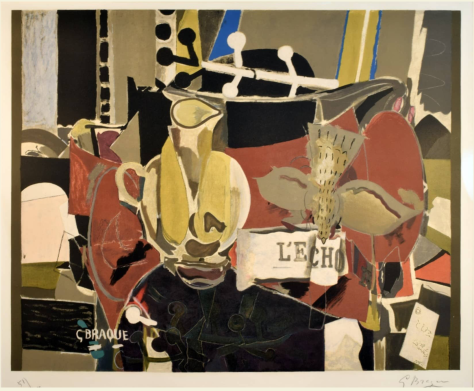Well the Missus and I trundled up to the Granite State over the weekend to check out the newly installed exhibits at Manchester’s Currier Museum of Art and say, they were swell.
We started at Fabricating Modernism: Prints from the School of Paris (through January 7), which features artworks that “constitute a small portion of an extensive collection of prints committed to the Currier Museum of Art. Most of these prints are dated from after World War II and created by artists working in the United States and Paris.”
Given the vast breadth of the collection, we have selected objects illustrating the collector’s passion for artists working in his beloved Paris, such as Pablo Picasso, Henri Matisse, Joan Miró, Marc Chagall, Sonia Delaunay, and Georges Rouault . . .
The School of Paris (French: École de Paris) refers to the French and émigré artists who worked in Paris in the first half of the 20th century. Considered by many as the cultural capital of Europe, Paris was also one of the first global cities.
Its multicultural and polyglot art community included many Americans, like artists Gertrude Stein, Sam Francis, Al Held, and Joan Mitchell, along with writers James Baldwin and Ernest Hemingway, to name a few.
It’s an interesting and varied collection, much of it drawn from the artists’ later years, such as Picasso’s linoleum cut Portrait of Jacqueline Full Face II above from 1962 when he was 81, or Sonia Delaunay’s 1969 color etching and aquatint Untitled when she was 84.
Ditto for Georges Braque’s L”Echo, a 1960 lithograph printed three years before his death at the age of 81.
All in all, a nice addition to the Currier’s already fine collection of over 15,000 objects.
Next door to that exhibit is Heart of a Museum: Saya Woolfalk (through February 4), “a new experiential installation.”
Saya Woolfalk’s (American, b. 1979) commission for the Currier Museum of Art investigates the history of the institution and revisits its iconography and original design.
The mosaics adorning the former main entrance of the Currier (designed by Salvatore Lascari in 1929–1930) constitute the starting point for this new installation by Woolfalk, which reimagines the Western art canon’s singular cultural perspective.
The artwork conceived by the artist for the Currier combines video projections, sculptural forms made of glass, wallpaper, and sound – creating an immersive environment where the viewer is invited to voyage, rest, and meditate as if in a sensorial temple.
In other words, maybe get a buzz on before entering the exhibit. (The Missus and I did not, for those of you keeping score at home.) Anyway, here’s a quick look from the show’s opening reception, compliments of Keith Spiro.
We also made the acquaintance of The Bead King in Sanaa Gateja: Selected Works (through January 14).
Prior to becoming one of the most prominent artists in East Africa, Sanaa Gateja (Ugandan, b. 1950) studied interior design in Italy and jewelry design at Goldsmiths in London. His intricate works oscillate between abstraction and figuration.
Each composition is a new exploration, a novel exercise in shaping forms or patterns with color and vice versa. Gateja’s art is primarily created using beads made from recycled paper, which he rolls, dyes, and affixes to bark cloth. This signature technique has earned him the nickname “the Bead King” in his home country, and for the last thirty years, he has taught it to local communities and across the entire region.
Sanaa Gateja’s work is both painstaking and lyrical, as this close-up segment of one design nicely illustrates.
The largest current exhibit at the Currier is Toward the New: A Journey into Abstraction (through March 31), which “presents a new collection-based exhibition looking at the long journey toward abstraction that encompasses its many manifestations.”
Many painters celebrated the physical properties of paint for its own sake – its thickness, texture, color – beyond its historic role as a transmitter of visual information, while sculptors used modern materials and industrial processes. Artists featured in this exhibition employed a variety of tools for inspiration, including complex compositional formulas, bold geometric forms, experiments in visual perception and arbitrary color, and the unconscious.
Many of the Currier’s all-time favorites are included in the show, such as Pablo Picasso’s Woman Seated in a Chair (1941), Josef Albers’s Homage to the Square: Early Rising I (1961), Alexander Calder’s Petit Disque Jaune (1967), and Joan Mitchell’s Cous-cous (1961–1962) [above].
Here’s senior curator Kurt Sundstrom in 2020 discussing Picasso’s painting, “Woman Seated in a Chair.”
On our way, out the Missus and I stopped by Currier Created (through January 7), a collection of artworks “featuring the artistic talents of the museum’s staff.”
Representative samples include Michelle Peterson’s acrylic on canvas Screen Time . . .
. . . and Jim Mooney’s linocut print The Outermost House.
The exhibit is a sweet tribute to those who make the Currier well worth a trundle this holiday season.









